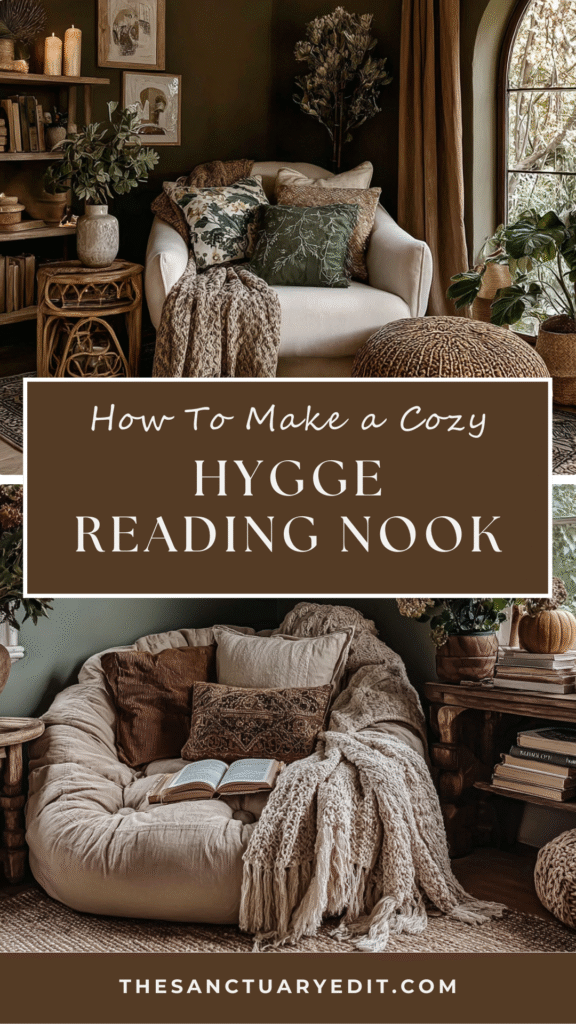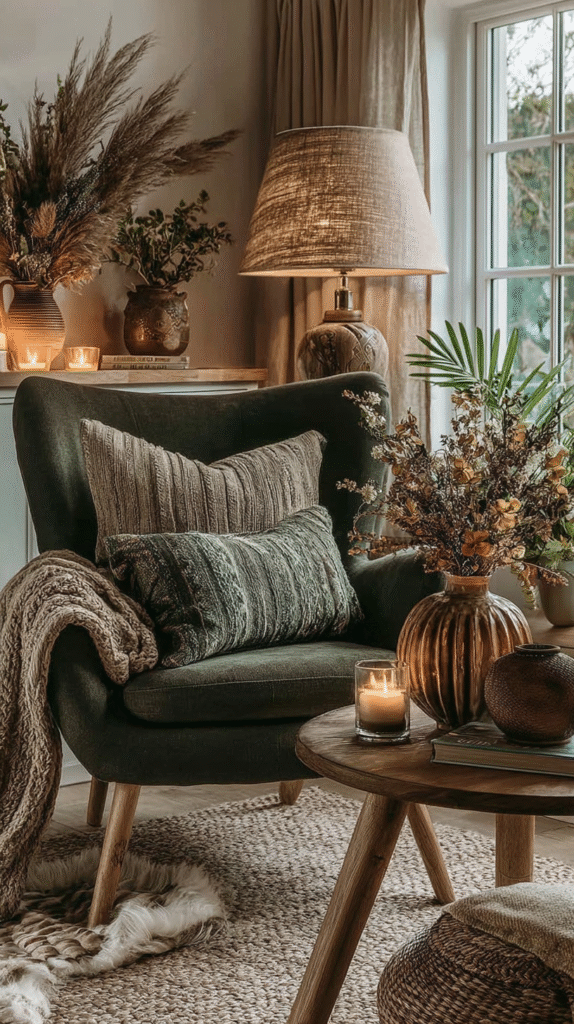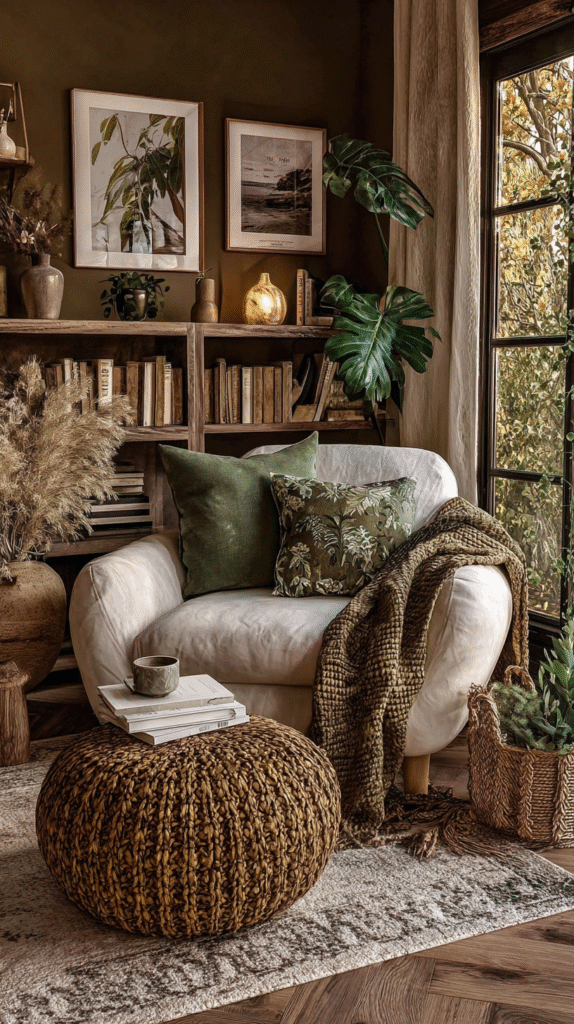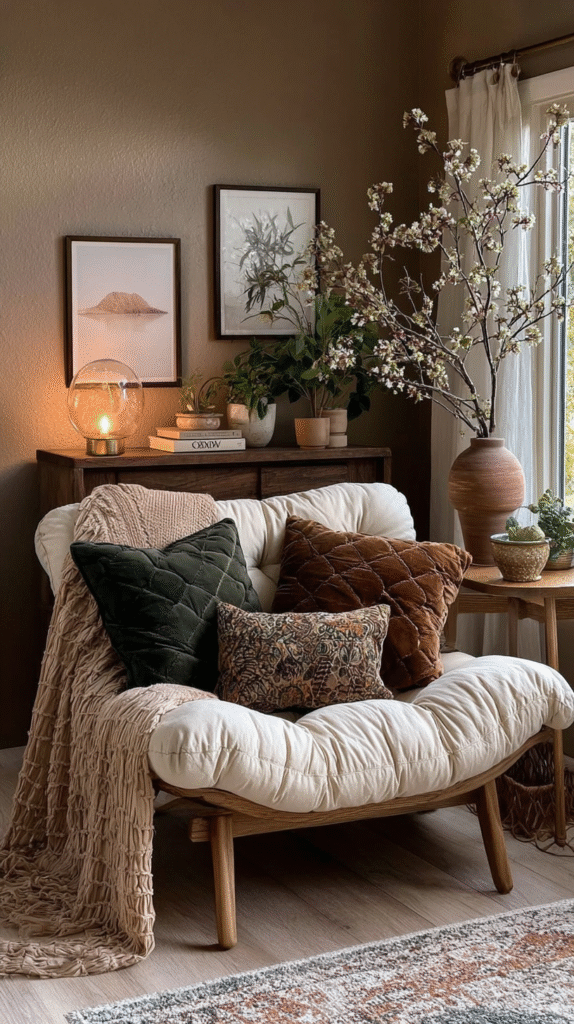This post may contain affiliate links, including those from Amazon Associates. If you make a purchase through these links, I may earn a commission at no additional cost to you. Learn more about our affiliate policy.
When the day feels heavy and overstimulated, a small corner can become medicine. The glow of a lamp, the softness of a wool throw, and the simple act of settling into a chair with a book can shift your whole nervous system.
A hygge reading corner, or hyggekrog as the Danes call it, is about creating a nook that feels like an exhale. With a few intentional edits, even the smallest apartment can hold a quiet place for rest and reflection.
Why a Hygge Reading Corner?
Hygge is often translated as coziness, but it carries more weight than that. It is about safety, warmth, and presence. A hyggekrog is a designated spot where you can retreat from the noise of the day and let your body soften.
This matters because our nervous systems respond to our environments. Bright lights, clutter, and constant screens keep the body in a state of alertness. A corner curated for calm gives your senses permission to downshift.
Research in design psychology shows that soft lighting, natural textures, and contained spaces can reduce overstimulation. Instead of spreading calm across an entire house at once, a single nook can anchor you.
It becomes a visible reminder that rest is allowed here.

Choosing the Right Spot
The first step is to notice where you already gravitate.
Perhaps there is a chair by a window where the light feels gentle, or a quiet corner of the bedroom that often goes unused. A hygge nook does not need much space. Even a single armchair with a small side table can be enough. What matters most is that the spot feels separate from the busiest areas of the home.
Look for natural light if possible. A corner near a window gives you the changing rhythm of the day, yet you will want to soften harsh glare with a sheer curtain.
If no window is available, lighting will carry the mood. More on that soon.
Layering Light

Lighting is the soul of hygge. Overhead lights are too harsh for a reading corner.
Instead, use soft, layered sources that create warmth without strain. A small table lamp, a floor lamp with a linen shade, or even a cluster of candles can transform the space.
The quality of light matters. Aim for warm, golden tones instead of cool, blue-white bulbs.
Dimmable options are ideal, allowing you to adjust brightness depending on the time of day. Layer your light: one lamp for reading, another softer source to wash the room in gentle glow.
Seating That Invites Rest

The seat you choose should feel like an invitation. A classic armchair works beautifully, but do not overlook a window seat, a chaise, or even a thick floor cushion layered with pillows. Comfort is more important than style.
Choose something you want to sink into.
To create a cocoon effect, add a footstool or pouf. Resting your legs helps the body relax more fully.
If you live in a small apartment, a folding chair with a plush throw can serve as a temporary nook. The point is not perfection, but intention.
Textures That Soothe
Once you have the seat, soften it with layers. Hygge is about tactile comfort: a wool blanket, linen cushions, a plush rug underfoot. Natural fabrics like cotton, wool, and linen breathe and carry a grounded texture.
Keep a blanket draped nearby so you can wrap yourself without effort.
Textures should be layered but not overwhelming.
Choose two or three: perhaps a chunky knit throw, a smooth linen pillow, and a soft sheepskin draped across the seat. The mix creates sensory richness without clutter.
Surrounding Yourself With Nature

A hygge nook feels most alive when it carries traces of the outdoors. A potted plant, a branch in a ceramic vase, or a small tray of stones gathered from a walk can ground you in the natural world.
If you have a window, consider positioning the nook where you can see the sky or a tree.
Wooden furniture and ceramic accents further this connection. The grain of oak, the cool touch of clay, the warmth of rattan — these organic elements regulate the nervous system in subtle ways. Nature reminds the body that it is safe.
If you love weaving the outdoors into your interiors, you might also enjoy these easy ways to bring nature indoors to create more calm.
A Calming Color Palette
The Danish way favors muted tones that quiet the eye. Soft whites, warm beiges, stone, clay, sage, and muted browns create visual calm. Avoid bright, saturated colors in this corner; they compete for attention and stimulate rather than soothe.
If you already have colorful pieces, balance them with neutrals. A bright chair can be softened with a neutral throw. The goal is harmony, not a strict palette.
For more inspiration, explore these calming bedroom colors that help you sleep better to see how gentle tones can transform a space.
Engaging All the Senses
Hygge is multi-sensory. Beyond sight and touch, think about scent and sound. A beeswax candle or a drop of lavender oil in a diffuser can signal to the body that it is time to unwind. The sound of quiet music, the hum of a kettle, or even silence itself can become part of the ritual.
Keep what you need nearby: a basket with your current book, a tray for tea, a coaster for a mug. The easier it is to settle, the more often you will use the nook.
Visual Inspiration
Sometimes it helps to see how others interpret hygge. This video gathers beautiful examples of hygge reading corners and cozy nooks, showing how soft light, intentional simplicity, and layered textures create an atmosphere that calms both body and mind.
Notice how each space is small, sometimes improvised, but always intentional. The common thread is not expensive furniture, but the care given to atmosphere.
Practical Styling Tips
- Contain clutter: Use a basket to store throws and pillows. Place books in a small stack rather than spread across the floor.
- Keep it seasonal: Rotate lighter fabrics in spring and summer, deeper textures in autumn and winter.
- Add a side table: Even a simple stool will hold a mug of tea, glasses, or a candle.
- Soften edges: A rug under the chair or a hanging textile behind it can visually anchor the corner.
- Personal touches: A framed photo, a favorite art print, or a handwritten poem can make the nook uniquely yours.

Maintaining the Ritual
A hygge corner only works if you use it. Make it part of a daily or weekly rhythm. Perhaps you spend ten minutes there after work before dinner, or you end the evening with a chapter of a book. These small rituals help signal to the nervous system that rest is available.
It is also helpful to reset the corner regularly. Fold the blanket, clear the table, straighten the pillows. The act of tending becomes a practice in itself, reminding you that this space is meant for care.
Building on this practice, you may find it helpful to design a weekly home reset that supports your nervous system.
Small Steps, Lasting Calm
Creating a hygge reading corner does not require new purchases or renovations. You can begin with what you already own: move a lamp, add a blanket, place a plant on a stool. Start with one shift and notice how it feels. Over time, the corner will evolve into a sanctuary that reflects you.
Remember, hygge is not about staging a perfect image. It is about cultivating safety, warmth, and presence in the middle of real life.
When you settle into your nook and feel your breath deepen, you will know you have created more than a reading space. You have created a sanctuary for your nervous system.






